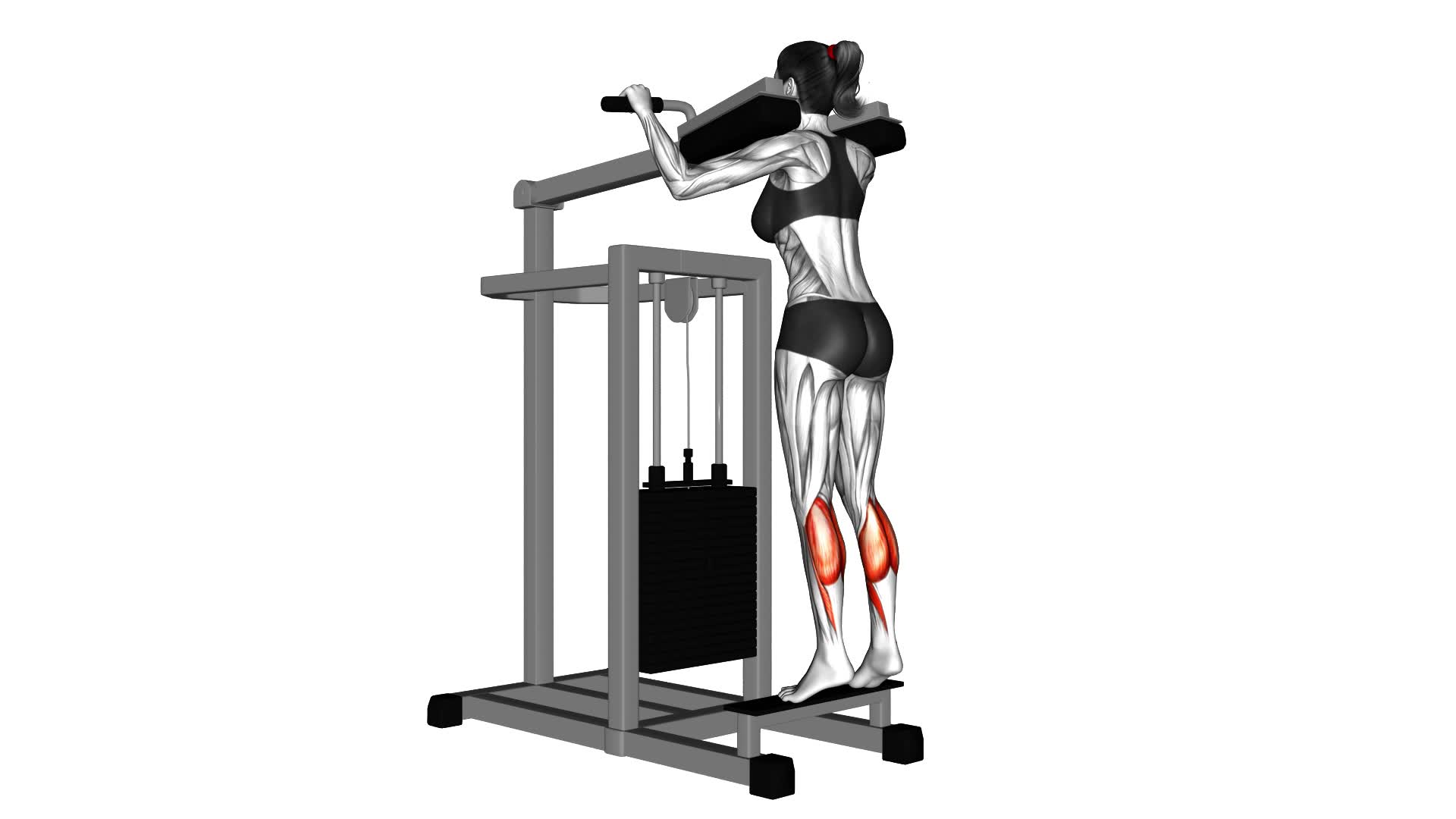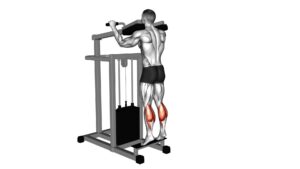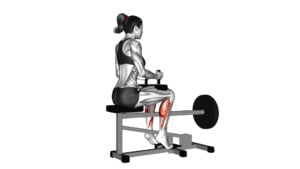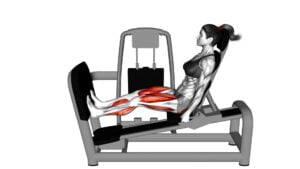Lever Standing Calf Raise (female) – Video Exercise Guide & Tips

Are you looking to strengthen and tone your calf muscles? Look no further than the Lever Standing Calf Raise exercise.
Watch This Exercise Video
In this video exercise guide, we'll show you the proper technique and form for this effective calf exercise. You'll also learn common mistakes to avoid and variations to challenge yourself.
Get ready to feel the burn and achieve those strong, sculpted calves you've always wanted. Let's dive in!
Key Takeaways
- Lever Standing Calf Raise targets and strengthens the calf muscles.
- Proper technique and setup are important for muscle activation and safe execution.
- Avoid common mistakes such as using excessive weight and bouncing at the bottom of the movement.
- Explore variations and progressions to customize the exercise based on individual goals and fitness level.
Benefits of Lever Standing Calf Raise
Get ready to experience the amazing benefits of the Lever Standing Calf Raise – it's a workout that will target and strengthen your calf muscles like never before. This exercise specifically focuses on the calf muscles, helping to build strength, definition, and stability in this area. By performing the Lever Standing Calf Raise regularly, you can expect to see impressive results in terms of calf muscle development and overall lower body strength.
One of the key benefits of the Lever Standing Calf Raise is its ability to isolate and target the calf muscles effectively. Unlike other calf exercises that may engage multiple muscle groups, this exercise hones in on the calves, allowing for maximum muscle activation and growth. This targeted approach leads to improved muscle definition and strength in the calves.
Another advantage of the Lever Standing Calf Raise is its versatility. Whether you're a beginner or an advanced fitness enthusiast, you can adjust the weight and resistance to suit your fitness level. This exercise can be easily modified to cater to your specific needs and goals, ensuring that you continue to challenge yourself and make progress over time.
With its ability to target the calves effectively and its adaptability to different fitness levels, the Lever Standing Calf Raise is a highly beneficial exercise that yields impressive results.
Now, let's move on to the equipment and setup required to perform this exercise.
Equipment and Setup
To set up for the Lever Standing Calf Raise, you'll need a lever calf raise machine and adjust the settings according to your fitness level. Here are three important things to consider for the equipment setup:
- Position yourself: Stand facing the machine with the balls of your feet on the foot platform and your heels hanging off the edge. Make sure your feet are hip-width apart, and your toes are pointing forward.
- Adjust the weight: Set the weight on the machine to an appropriate level for your strength and goals. Start with a lighter weight and gradually increase as you become more comfortable with the exercise.
- Engage your muscles: Before starting the exercise, activate your calf muscles by squeezing them tightly. This will help you to maintain tension and maximize the effectiveness of the exercise.
Proper equipment setup is crucial for muscle activation and getting the most out of your Lever Standing Calf Raise. By following these steps, you can ensure that you're in the correct position and ready to perform the exercise safely and effectively.
Now that you're all set up, let's move on to the next step in the Lever Standing Calf Raise exercise guide.
Proper Technique and Form
Engage your core and maintain a stable stance throughout the Lever Standing Calf Raise exercise. This will help you maintain balance and stability throughout the movement.
To begin the exercise, position yourself on the lever standing calf raise machine with your toes on the edge of the platform and your heels hanging off. Place your hands on the handles for support.
As you start the exercise, slowly raise your heels by pushing through the balls of your feet. Focus on squeezing your calf muscles at the top of the movement to maximize calf muscle activation. Hold this position for a brief moment before slowly lowering your heels back down to the starting position.
To prevent injury, it's important to maintain proper form throughout the exercise. Avoid using momentum or swinging your body to lift the weight. Instead, focus on controlled movements and a slow and controlled descent. This will help you target the calf muscles effectively and minimize the risk of strain or injury.
Remember to breathe throughout the exercise and to not hold your breath. Engaging your core and maintaining proper form won't only help you activate your calf muscles effectively, but also ensure a safe and efficient workout.
Common Mistakes to Avoid
Maintain proper form throughout the Lever Standing Calf Raise exercise to avoid common mistakes and maximize your calf muscle activation. Here are three common mistakes to avoid when performing this exercise:
- Using too much weight:
One of the biggest mistakes people make during the Lever Standing Calf Raise is using excessive weight, which can lead to poor form and increase the risk of injury. It's important to start with a manageable weight and gradually increase it as your strength improves.
- Bouncing at the bottom:
Another common mistake is bouncing at the bottom of the movement. This not only reduces the effectiveness of the exercise but also puts unnecessary strain on your Achilles tendon. Instead, focus on a controlled and smooth range of motion, going through the full range of movement without any bouncing.
- Neglecting proper alignment:
Proper alignment is crucial for injury prevention and muscle activation. Make sure your feet are hip-width apart, with your toes pointing forward. Keep your core engaged and your spine neutral throughout the exercise. Avoid leaning forward or using momentum to lift the weight.
By avoiding these common mistakes, you can ensure a safe and effective Lever Standing Calf Raise. However, if you still find it challenging or want to switch things up, there are alternative exercises like the seated calf raise or the calf press on a leg press machine.
Now, let's explore some variations and progressions to take your calf training to the next level.
Variations and Progressions
For more challenging variations and progressions of the Lever Standing Calf Raise exercise, you can incorporate different foot positions and increase the range of motion. These advanced techniques will help to activate your calf muscles even more effectively.
One variation you can try is the single-leg Lever Standing Calf Raise. Instead of using both legs, you'll perform the exercise on just one leg at a time. This increases the intensity and requires more balance and stability.
Another variation is the seated Lever Standing Calf Raise. Instead of standing, you'll sit on a bench or chair with your feet flat on the lever platform. This variation targets your calf muscles from a different angle and can be a great way to mix up your routine.
To further progress the exercise, you can increase the range of motion by using a step or platform. Place the balls of your feet on the edge of the step, allowing your heels to lower below the level of the step. This increased range of motion will challenge your calf muscles even more and help to build strength and size.
Tips for Effective Calf Training
To maximize the effectiveness of your calf training, incorporate these three key tips:
- Focus on calf muscle activation: When performing calf exercises, it's important to concentrate on engaging your calf muscles fully. Visualize the muscles working and contract them forcefully during each repetition. This will help to ensure that you're targeting the calves specifically and maximizing their growth potential.
- Incorporate calf stretching techniques: In addition to strengthening exercises, calf stretching is crucial for maintaining flexibility and preventing injuries. Prioritize stretching your calves before and after your workout. Include static stretches, such as the standing calf stretch, where you place your hands on a wall and lean forward with your back leg straight and heel on the ground. Hold the stretch for 20-30 seconds on each leg.
- Gradually increase resistance: To continually challenge your calf muscles and promote growth, gradually increase the resistance or weight used in your calf training. This can be achieved by using heavier dumbbells or adding weight plates to a calf raise machine. By progressively overloading your calves, you'll stimulate muscle growth and strength gains.
Frequently Asked Questions
How Many Times per Week Should I Perform the Lever Standing Calf Raise Exercise?
Performing the lever standing calf raise exercise is a great way to strengthen your calves. To maximize the benefits, it's important to know how often to do it.
Without the context of the specific exercise, it's generally recommended to include calf strengthening exercises in your routine 2-3 times per week. This frequency allows your muscles to recover and grow stronger while avoiding overtraining.
Remember to always listen to your body and adjust the frequency as needed.
Can I Perform the Lever Standing Calf Raise Exercise if I Have Knee or Ankle Issues?
If you have knee or ankle issues, you may be wondering if it's safe to perform the lever standing calf raise exercise. Can you modify this exercise to accommodate your condition?
It's important to consider your safety and comfort. Consulting a medical professional or a trained fitness instructor would be a good idea. They can assess your specific situation and provide guidance on whether it's safe for you to perform this exercise or suggest appropriate modifications.
How Long Should I Hold the Contraction at the Top of the Movement During the Lever Standing Calf Raise Exercise?
To properly perform the lever standing calf raise exercise, it's important to know how long to hold the contraction at the top of the movement.
You might be wondering, 'How long should I hold it?'
Well, the ideal time is about 1-2 seconds.
This allows your calf muscles to fully engage and get the most out of the exercise.
Is It Better to Perform the Lever Standing Calf Raise Exercise With a Slow or Fast Tempo?
When it comes to the lever standing calf raise exercise, you might be wondering if it's better to perform it with a slow or fast tempo.
Well, let's break it down for you. Performing the exercise with a slow tempo can help increase time under tension, which can lead to more muscle growth.
On the other hand, performing it with a fast tempo can help improve power and explosiveness.
Can I Perform the Lever Standing Calf Raise Exercise on a Different Type of Calf Machine if a Lever Machine Is Not Available?
Yes, if a lever machine isn't available, you can perform the lever standing calf raise exercise on a different type of calf machine.
Look for an alternative calf machine that allows you to perform a similar movement, targeting the calf muscles.
You may need to make some modifications to adapt the exercise to the different machine, but it should still provide a good workout for your calves.
Conclusion
In conclusion, the lever standing calf raise is a great exercise for strengthening and toning the calf muscles. By using a lever machine, you can target the calves effectively and safely. Proper technique and form are crucial to avoid common mistakes and maximize your results.
By incorporating variations and progressions, you can continue challenging your calves and preventing plateaus. Remember to follow these tips for effective calf training and enjoy stronger and more defined calves.

Author
Years ago, the spark of my life’s passion ignited in my mind the moment I stepped into the local gym for the first time. The inaugural bead of perspiration, the initial endeavor, the very first surge of endorphins, and a sense of pride that washed over me post-workout marked the beginning of my deep-seated interest in strength sports, fitness, and sports nutrition. This very curiosity blossomed rapidly into a profound fascination, propelling me to earn a Master’s degree in Physical Education from the Academy of Physical Education in Krakow, followed by a Sports Manager diploma from the Jagiellonian University. My journey of growth led me to gain more specialized qualifications, such as being a certified personal trainer with a focus on sports dietetics, a lifeguard, and an instructor for wellness and corrective gymnastics. Theoretical knowledge paired seamlessly with practical experience, reinforcing my belief that the transformation of individuals under my guidance was also a reflection of my personal growth. This belief holds true even today. Each day, I strive to push the boundaries and explore new realms. These realms gently elevate me to greater heights. The unique combination of passion for my field and the continuous quest for growth fuels my drive to break new ground.







